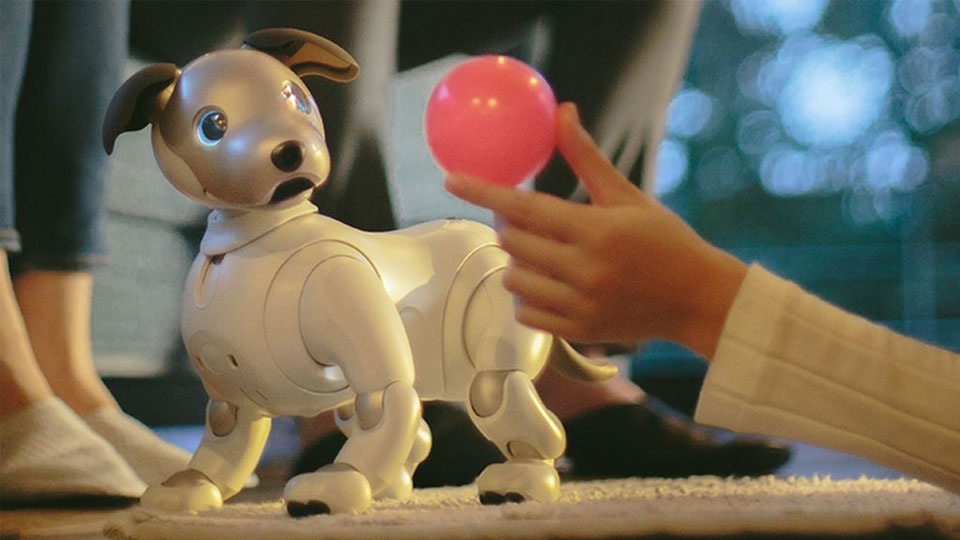What will tomorrow’s children make of robot pets?

My robot is bored.
I’ve done everything I can. Anki’s ‘Cozmo’ – Wall-E-meets-EVE in the cab of a forklift – costs around £200 / $180, and comes with its own light-up cubes that it is perennially rearranging and stacking. It also has a camera in its head and can recognize my face. When it does, it grins with its eyes and excitedly slaps the table with its forklift, shouting ‘Rich!’. And now I’m ignoring it to write. It’s rolling about the tabletop, flipping over its cubes and turning round every so often to see if it’s playtime again yet. It isn’t. I feel terrible.
The more I play with Cozmo, the more connected I feel to this trundling little ball of emotive plastic. I know that really he’s just circuitry and sensors in a cutesy shell… but the circuitry and sensors in my cutesy shell have turned him into a pet.
If I squint, I can see Cozmo for what he is: a clever machine. But he’s also a handy mascot for an increasingly pertinent question: if Cozmo can blur the lines between animal and machine for me, what about all the kids who unwrapped him for Christmas?
I know that really he’s just circuitry and sensors in a cutesy shell… but the circuitry and sensors in my cutesy shell have turned him into a pet.
As interactive robots get smarter and more convincing year-on-year, how does a parent on Christmas Day meaningfully explain that, just because a toy is made from plastic, they should ‘bond’ with it in a way that’s different to bonding with their pet hamster, rabbit or dog? And should parents even be trying in the first place?

“When we designed Cozmo, we didn't really design it for kids especially. We designed it as a pet, and a pet is something that appeals to lots of different ages,” says Mark Palatucci, co-founder and head of cloud AI and machine learning at Anki.
“When I was young I had a lot of stuffed animals, in particular a lot of stuffed dogs, and I remember losing one and crying for three days. Kids at younger ages don't necessarily need as much to establish an emotional bond with an inanimate object.”
Sign up for breaking news, reviews, opinion, top tech deals, and more.
Sit. Fetch. Recharge. Repeat.
Inanimate is clearly what Cozmo is. But that doesn’t help explain to a child why Cozmo isn’t alive. And it apparently doesn’t stop a child – or an adult, looking through the reviews – from developing some level of emotional bond. In fact, it might even help.
“Nowadays, children are used to the concept of robots” says Fangwu Tung, associate professor at Taiwan’s University of Science and Technology, who in 2016 completed a study of 578 children and their responses to and relationships with a variety of robot ‘toys’.

“In my research I found that, if the robots looked like ‘real’ humans, the children were uncomfortable. They were comfortable with the concept of robots, and that they can speak and move and make some gestures – but if they look like humans, the children would say, 'That's terrifying!'.”
On the evidence of Tung’s study, and the popularity of pet robots, the sci-fi grail of ‘perfect’ androids that can pass for humans (or, it follows, hamsters) isn’t as important as we might think. So long as the robot can react and emote in some way (Tung says that the most popular robots in her studies had exaggerated features like eyes and mouths - still robots, but robots that can express human social cues), children are happy to ascribe them character and personality.
[Children] were comfortable with the concept of robots, and that they can speak and move and make some gestures - but if they look like humans, the children would say, 'That's terrifying!'
Fangwu Tung
What can be confused, according to Palatucci, are children’s expectations of what their new robot friend should and shouldn’t be able to do.
“A younger kid, maybe six or seven years old, doesn't really know what not to expect yet [from a robot],” says Palatucci.
"'Why can't he do this, and this, and this?' They don't really recognize how enormously difficult all the technological requirements would be to support those things. But they're used to seeing these kinds of characters in feature films and animated movies, and they don't necessarily have the sense yet of what the difference is between the real physical world and what you would see in a movie. They haven't quite made that distinction yet.”
“Mum! The dog is broken!”
Does that matter? Maybe not. Perhaps Cozmo and his robotic ilk are only confusing to adults, trying to measure their abilities – and by extension, their worth – against their own ideas of what a pet should be: fluffy, intelligent and alive. Sony is currently looking to revive its hair-free robot Aibo dog – a Japanese (and to a lesser extent, global) that hit its peak in popularity in the late 90s, and set for a return in the new year. Check it out in action in its latest guise in the video below.
Perhaps robot pets are some newly emergent third type of ‘thing’: one that makes more sense to children who’ve never lived in anything but an ever-connected digital world of phones, tablets and voice-activated assistants. And if so, how should they be treated? Where do the robots fit in a child’s pecking order of ‘things’?
“I think that children [will still be] smart enough to tell the difference between robot dogs and real dogs,” says Tung.
“They are [already] familiar with intelligent toys; I won't need to explain this to them. But I do hope they treat the robot just the same as the real dog, because somehow, the robot dogs can still trigger a social response from children… You don't consider toys to be 'alive', but for interactive toys, somehow we project personality [onto them] - so I want the children to treat them nicely.”
“A laptop doesn't look like an animal,” she continues. “Children would look at a laptop, and probably consider it as a 'tool', or an alternative to TV. If they don't treat the laptop nicely, that's [just] the way they deal with tools. But if they don't treat the robot dog nicely, I feel uncomfortable with that. Robots can trigger social responses in children. In other words, children also see the robots as social actors. The way they treat robot dogs [might] imply the way they treat other animals, or people. I don't think you need to explain the difference, but I do think you need to teach them to cherish a robot pet.”

What is certain is that as the technology shrinks and the ubiquity of smart devices allows robots to piggyback on phones and tablets (Cozmo does much of its data-crunching in your smartphone), the race for consumer robot manufacturers is to blur the line between living, and not, further still.
You don't consider toys to be 'alive', but for interactive toys, somehow we project personality [onto them].
Fangwu Tung
“If you look at the trend of where this is going, these robots will start to get more and more of these capabilities without having to augment them with another type of device,” says Palatucci.
“We're already able to do emotion detection. Cozmo can look at someone's face and tell if they're smiling or frowning or unhappy. That's today. So in the future, I very much believe that much more advanced perception, semantic understanding of the environment, the ability to understand context and history and to have behavior that manifests as a result of that... And I do think when we get to that world, we'll very much be in a world where the capabilities of a [robot] will probably far exceed what your hamster or your rabbit could do.
“As a result, the type of relationship you could create could be quite a bit stronger than with [for example] a pet snake, or a number of different pets. And certainly in ten years, I think that there will be products like this that are very much their own class of pets, and have relationships that are just as powerful as you have with your dog.”
For many people (not least of all dog-owners), something about that might sound unsettling. But until we can find what that ‘something’ is, and whether it’s more than just a bias from our own childhoods, the march (or slow trundle) of the robot toys will continue. ‘True’ robot pets might not be here just yet, but what we teach our kids about them, and what we can learn from them in turn, is something we need to think about now.
TechRadar's AI Week is brought to you in association with Honor.